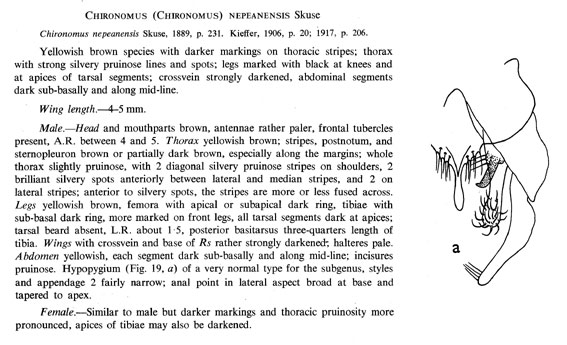C. nepeanensis Skuse, 1889 A larger species with a dark spot over the crossvein and with dark knees. In BOLD Bin: BOLD:AAG7038
Chironomus 'atchleyi' is in the same Bin.
Description from Freeman(1961)See the original description by Skuse 1889 along with additional data on the type male. Further data from additional specimens:
Males:
AR - 3.75 (3.55-4.60).
Wing length 4.39-4.56 mm., width 1.01mm. VR - 0.98-1.00.
Thoracic setae: Acrostichal about 9+-18+; dorsolateral 14+-31; prealar 5-8; supraalar 1; scutellar in 3 approximate rows 8-13, 6-13 and 16-23 (totals 34-49).
Leg lengths and proportions (micron):
| Fe
| Ti
| Ta1
| Ta2
| Ta3
| Ta4
| Ta5
| LR
| F/T
| BR
| PI
| 1418
| 1382
| 2133
| 1194
| 900
| 913
| 438
| c. 1.2-1.59
| 0.97-1.08
| 1.91-2.11
| PII
| 1593
| 1585
| 898
| 542
| 394
| 246
| 171
| 0.55-0.60
| 0.95-1.04
| -
| PIII
| 1752
| 1794
| 1310
| 720
| 541
| 326
| 206
| 0.55-0.72
| 0.92-1.03
| -
| 
Hypopygium of C. nepeanensis
Note superior volsella of the E-type.Abdominal segments with a proximal dark band and a posteriorly directed median extension. About 8-17 setae on tergite IX. Superior volsella of the E-type; Inferior volsella with simple setae and reaching about to end of anal point; gonostylus moderately swollen and tapering relatively sharply over posterior half.Female: Freeman (1960) notes only that it is similar to male but markings darker, thoracic pruinosity more pronounced and apices of tibiae may also be darkened.
To this may be added:
Wing length 4.07-4.47 mm., width about 1.11 mm. AR abt 0.34 (0.32-0.38), A5/A1 abt. 1.24 (1.20-1.30).Thoracic setae: Acrostichal -abt 12-20; Dorsolateral at least 32-45 (about 11-12 in a cluster anterior to parapsidal suture); Prealar 6 (3-9); Supra-alar - 1; Scutellar - in 2 rows, about 18 in ant. row and 20 in post. row.
Leg lengths (micron) and proportions:
| Fe
| Ti
| Ta1
| Ta2
| Ta3
| Ta4
| Ta5
| LR
| F/T
| Ta4/Ti
| PI
| 1590
| 1426
| 2387
| 1167
| 945
| 981
| 442
| 1.59-1.74
| 1.03-1.18
| 0.58-0.75
| PII
| 1638
| 1595
| 860
| 515
| 375
| 225
| 165
| 0.50-0.62
| 0.97-1.23
| -
| PIII
| 1753
| 1693
| 1303
| 775
| 590
| 340
| 205
| 0.67-0.73
| 0.89-1.03
| -
| BR 1.50-2.33 Found: New South Wales - Barrington Tops abt 2 Km nw. Dungog; Glenbrook Lagoon (33.757°S, 150.615°E); Hill Head (31.063°S, 153.052°E)
(BOLD); 25 Km s. Narrabri; Nepean River, Penrith (Type locality); Blue Lagoon, Red Rocks National Park (Timms 1982).
Northern Territory - Island Lagoon (12.57°S, 132.88°E) and Radon Creek (12.75°S, 132.93°E), Kakadu National Park;
Manbulloo Station (Freeman 1961).
Queensland - Berner Creek; Burpengary (27.15°S, 152.97°E); Cairns; Lake Eacham (17.300°S, 143.633°E), 20 Km e. Atherton;
Eidsvold; Gatton; Innisfail; Mary Smokes Creek, nr. Kilcoy (26.95°S, 152.67°E); Kilcoy (26.93°S, 152.55°E); Lake Manchester;
University of Queensland, St. Lucia; Somerset Dam; nr Townsville (19.3811°S, 146.449°E) (BOLD).
Western Australia - Hammersley Range, Fortescue (21.88°S, 166.77°E); Millstream Station (21.59°S, 117.08°E) (all Freeman 1961). Normally in depths of over a meter, but may also occur in some shallower permanent pools where the larvae may be much smaller, particularly if collected in the summer.W.R. Atchley, on the basis of unpublished work on the sequences of the polytene chromosomes, suggested that there were two species included, one in the south and the other in the north. Subsequent work confirms this conclusion since, in addition to the differences in chromosome sequence, there is a small but consistent difference in the COI Barcode sequences (see below) that indicate the existence of two allopatrically distributed groups: one of N.S.W., Queensland and Northern Territory specimens (C. nepeanensis), the other of South Australian and Victorian specimens (for which the name 'C. atchleyi' is proposed). The status of the two Western Australian populations recorded by Freeman (1961) is uncertain, but given their northern location in that state, it is likely that they would be C. nepeanensis. See also C. nepeanensis immatures[ Go to C. atchleyi | Return to Index | Go to References ] |

